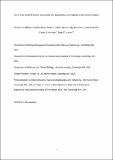| dc.contributor.author | Offeddu, Giovanni | |
| dc.contributor.author | Haase, Kristina Michelle | |
| dc.contributor.author | Gillrie, Mark Robert | |
| dc.contributor.author | Li, Ran | |
| dc.contributor.author | Morozova, Olga | |
| dc.contributor.author | Hickman, Dean | |
| dc.contributor.author | Knutson, Charles G. | |
| dc.contributor.author | Kamm, Roger Dale | |
| dc.date.accessioned | 2020-10-29T22:37:39Z | |
| dc.date.available | 2020-10-29T22:37:39Z | |
| dc.date.issued | 2019-08 | |
| dc.date.submitted | 2019-04 | |
| dc.identifier.issn | 0142-9612 | |
| dc.identifier.uri | https://hdl.handle.net/1721.1/128263 | |
| dc.description.abstract | Recent therapeutic success of large-molecule biologics has led to intense interest in assays to measure with precision their transport across the vascular endothelium and into the target tissue. Most current in vitro endothelial models show unrealistically large permeability coefficients due to a non-physiological paracellular transport. Thus, more advanced systems are required to better recapitulate and discern the important contribution of transcellular transport (transcytosis), particularly of pharmaceutically-relevant proteins. Here, a robust platform technology for the measurement of transport through a human endothelium is presented, which utilizes in vitro microvascular networks (MVNs). The self-assembled MVNs recapitulate the morphology and junctional complexity of in vivo capillaries, and express key endothelial vesicular transport proteins. This results in measured permeabilities to large molecules comparable to those observed in vivo, which are orders of magnitude lower than those measured in transwells. The permeability of albumin and immunoglobulin G (IgG), biopharmaceutically-relevant proteins, is shown to occur primarily via transcytosis, with passage of IgG regulated by the receptor FcRn. The physiological relevance of the MVNs make it a valuable tool to assess the distribution of biopharmaceuticals into tissues, and may be used to prioritize candidate molecules from this increasingly important class of therapeutics. | en_US |
| dc.language.iso | en | |
| dc.publisher | Elsevier BV | en_US |
| dc.relation.isversionof | http://dx.doi.org/10.1016/j.biomaterials.2019.05.022 | en_US |
| dc.rights | Creative Commons Attribution-NonCommercial-NoDerivs License | en_US |
| dc.rights.uri | http://creativecommons.org/licenses/by-nc-nd/4.0/ | en_US |
| dc.source | Prof. Kamm via Elizabeth Soergel | en_US |
| dc.title | An on-chip model of protein paracellular and transcellular permeability in the microcirculation | en_US |
| dc.type | Article | en_US |
| dc.identifier.citation | Offeddu, Giovanni S. et al. "An on-chip model of protein paracellular and transcellular permeability in the microcirculation." Biomaterials 212 (August 2019): 115-125 © 2019 Elsevier Ltd | en_US |
| dc.contributor.department | Massachusetts Institute of Technology. Department of Biological Engineering | en_US |
| dc.contributor.department | Massachusetts Institute of Technology. Department of Mechanical Engineering | en_US |
| dc.relation.journal | Biomaterials | en_US |
| dc.eprint.version | Author's final manuscript | en_US |
| dc.type.uri | http://purl.org/eprint/type/JournalArticle | en_US |
| eprint.status | http://purl.org/eprint/status/PeerReviewed | en_US |
| dc.date.updated | 2020-10-28T17:56:14Z | |
| dspace.orderedauthors | Offeddu, GS; Haase, K; Gillrie, MR; Li, R; Morozova, O; Hickman, D; Knutson, CG; Kamm, RD | en_US |
| dspace.date.submission | 2020-10-28T17:56:28Z | |
| mit.journal.volume | 212 | en_US |
| mit.license | PUBLISHER_CC | |
| mit.metadata.status | Complete | |
